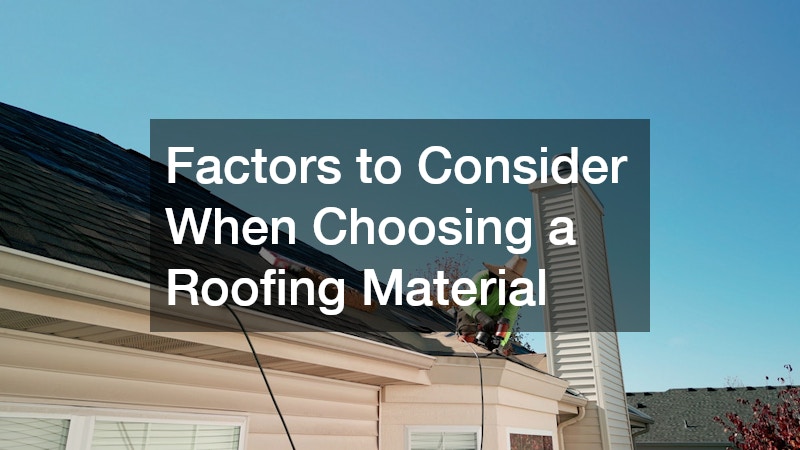When it comes to protecting your home, the roof plays one of the most vital roles. The type of roofing material you choose impacts not only the look of your home but also its durability, energy efficiency, and maintenance needs. With so many options available, homeowners often turn to roofing companies for guidance on selecting the best material. Below is a comparison of the most common roofing materials to help you make an informed decision.
Asphalt Shingles: A Popular Choice
Asphalt shingles are among the most widely used roofing materials in the United States. Known for their versatility, they come in a variety of colors and styles, making them suitable for many different architectural designs. Asphalt shingles are relatively lightweight, which means they can be installed on most homes without requiring additional structural support.
Another advantage is their performance in various climates. They handle seasonal changes well, offering a balanced mix of durability and aesthetic appeal. For many homeowners, asphalt shingles serve as a reliable choice that balances longevity with easy maintenance.
Metal Roofing: Durable and Long-Lasting
Metal roofing has gained popularity in recent years thanks to its impressive durability. Materials such as steel, aluminum, and copper are used to create roofs that can last for decades with minimal upkeep. Metal roofs are resistant to common issues like warping, cracking, or rotting, and they hold up well against severe weather conditions.
Another standout feature of metal roofing is its reflective surface, which can help reduce heat absorption. This makes it especially attractive in warmer climates, where keeping homes cooler is a priority. Metal roofing also complements both modern and traditional architectural styles, making it a versatile choice for homeowners seeking durability with a sleek appearance.
Tile Roofing: Timeless and Elegant
Clay and concrete tiles have been used for centuries, known for their timeless beauty and impressive longevity. These roofing materials offer a distinct aesthetic, often associated with Mediterranean, Spanish, or Southwestern-style homes. The natural colors and textures of tiles enhance curb appeal, making them a favorite for homeowners who want a striking exterior.
Tile roofing is also fire-resistant and holds up well under various weather conditions. While it is heavier than other options, many roofing companies provide guidance on whether a home’s structure can support the additional weight. For those who can accommodate it, tile roofing combines elegance with durability in a way few other materials can match.
Wood Shingles and Shakes: Natural Beauty
For homeowners drawn to a rustic, natural look, wood shingles and shakes provide an unmatched charm. Typically made from cedar, redwood, or pine, wood roofing materials age gracefully, developing a unique patina over time. They blend beautifully with natural surroundings, making them a popular choice in rural or wooded areas.
Wood roofing materials also offer good insulation, helping homes stay comfortable in both warm and cold conditions. However, they do require regular maintenance to preserve their appearance and performance. With the right care, wood shingles and shakes can deliver both beauty and functionality.
Slate Roofing: Classic Strength
Slate roofing is often considered the pinnacle of strength and elegance. Known for its natural stone composition, slate can last for many decades, sometimes even more than a century. Its distinctive appearance adds sophistication to any home, making it especially popular for historic or high-end properties.
Beyond aesthetics, slate is highly resistant to fire, moisture, and extreme weather. Its weight, however, is significant, and not all homes can support it without reinforcement. Homeowners interested in slate should consult experienced roofing companies to determine whether their structure is suitable. When properly installed, slate roofing offers unmatched durability and timeless appeal.
Synthetic Roofing Materials: Modern Innovation
Advancements in technology have led to the creation of synthetic roofing materials that mimic the look of natural products such as slate or wood. Made from rubber, plastic, or polymer blends, these options combine aesthetic versatility with practical performance. Synthetic materials are often lighter than their natural counterparts and easier to install, making them accessible to more homeowners.
They also tend to be highly durable and resistant to common roofing challenges such as cracking or warping. With a wide range of styles and colors available, synthetic roofing materials provide homeowners with modern solutions that balance appearance and functionality.
Factors to Consider When Choosing a Roofing Material
Selecting the right roofing material goes beyond appearance. Homeowners should take into account factors such as:
-
Climate Compatibility: Some materials perform better in hot, dry conditions, while others excel in areas with heavy rain or snow.
-
Durability Needs: Consider how long you want the roof to last and how much maintenance you are willing to commit to.
-
Weight and Structure: Heavier materials like tile and slate require strong structural support.
-
Aesthetic Preferences: Your roof should complement the style of your home.
-
Environmental Impact: Some materials, such as metal or synthetic options, may offer eco-friendly benefits.
The roof is more than just a protective layer—it defines the character of your home and contributes to its long-term performance. Whether you are drawn to the classic look of slate, the modern innovation of synthetic materials, or the widespread reliability of asphalt shingles, each option has its strengths. By comparing roofing materials carefully and working with trusted roofing companies, homeowners can ensure they choose a roof that meets both functional and aesthetic needs.

